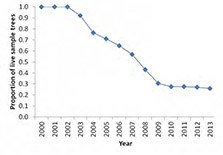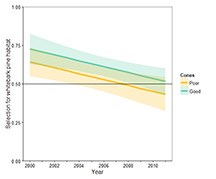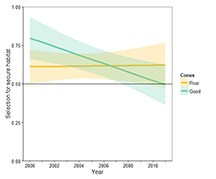
Cecily M. Costello, Frank T. van Manen, Mark A. Haroldson, Michael R. Ebinger, Steven L. Cain, Kerry A. Gunther, & Dan D. Bjornlie From Yellowstone Science 23(2): 2015, pages 12-16. In early summer, an industrious red squirrel climbs the trunk of a whitebark pine tree, scampers out to the end of a high limb, and snips off a cone that falls to the ground below. After dropping an ample collection of these cones, the squirrel carries them to a cool, moist place at the base of a large tree and buries them beneath the pile of discarded cone scales that have accumulated under a favorite feeding perch. Thus begins a routine that will occupy the squirrel for the weeks and months ahead as it stocks this and other larder-hoards, or middens, with foods it plans to subsist on during the long cold winter. However, not all of the squirrel's hard-won riches will last that long because in early fall, a grizzly bear may come sniffing about and usurp the calorie-rich stash of food. Ignoring the furious chatter coming from the branches above, the bear will dig up the midden's precious whitebark pine cones, carefully extract their seeds with dexterous claws, lips, and tongue, and consume the bulk of the cache in one sitting. Ah, the benefits of being a griz!
A relic from the ice age, whitebark pine in the Greater Yellowstone Ecosystem is now restricted to only the highest and coldest timbered zones, flourishing in extremes where other trees perish. In a stand of pure whitebark pine, far removed from roads and humans, a person might imagine they have stumbled into a fairy tale forest. Picture a canopy of curving, intertwined branches above large twisted trunks with rough flaky bark and the ground blanketed by the delicate, lime-green leaves of grouse whortleberry. As enchanting as such a forest might be, it is not the place where our narrative occurs. Red squirrels are largely absent from pure whitebark stands. A squirrel needs a variety of foods, so it would be unwise to place all its hopes on whitebark pine's unpredictable crops, not to mention their attractiveness to bears. No, the setting for our story is a mixed forest stand where whitebark pine intermingles with lodgepole pine, Engelmann spruce, and subalpine fir. The seeds of these other species may not have the calorie count of whitebark seeds, but they are more reliable. The large seeds, or nuts, of whitebark pine are a high-energy food rich in fats, carbohydrates, and protein. This makes them a sought-after resource for bears fattening up in the fall before denning. But obtaining seeds is a challenge for ground dwellers;whitebark pine cones are indehiscent, which means they do not split open to scatter seeds when mature. Mature grizzly bears are poor tree climbers, so they must rely on red squirrels to harvest and concentrate the crop.In the end, these twists of nature help grizzly bears and make midden-raiding of whitebark pine seeds a worthwhile part of the grizzly diet. The value of whitebark pine in bear diets has been recognized for many years, so the Interagency Grizzly Bear Study Team (IGBST) began documenting annual cone production in the GYE in 1980.Seed crops are quite variable, largely because of an adaptive tendency for trees to synchronize reproduction, referred to as a "masting" event. Producing occasional crops large enough to satiate seed consumers (e.g., squirrels, birds, bears) helps ensure that some seeds are left to germinate. In the GYE, large cone crops occur every 1 to 4 years, averaging every 2 years. Consumption by bears is correlated with this annual availability. During the 1970-1980s, seeds comprised 50–80% of fall scats when cone production was high, but were absent or scarce in scats when cone production was low (Mattson et al. 1991).Annual whitebark cone abundance has been linked with changes in grizzly bear survival, reproduction, movement, and frequency of management actions (Blanchard and Knight 1991, Mattson et al. 1992, Gunther et al. 2004, Schwartz et al. 2006).Abundant cone crops may influence nutrition, but they also affect bear foraging behaviors in ways that likely decrease vulnerability to human-caused mortality. When whitebark pine production is good, grizzly bears tend to use higher elevations, where the risk of bear-human conflict is lower and survival is higher (Schwartz et al. 2010). Several emerging threats to whitebark pine have focused attention on the grizzly bear-whitebark relationship during the last decade. As a cold-adapted species, whitebark pine is vulnerable to climate change by a variety of agents. In the GYE, the most immediate threat has been the mountain pine beetle, a cambium-feeding insect that usually kills its pine host to reproduce. Historically limited by low winter temperatures at high elevations, recent beetle outbreaks, facilitated by warmer temperatures, have expanded into whitebark pine range and caused mortality within about 82% of the whitebark pine stands in the GYE (Macfarlane et al. 2013). Larger, mature trees are most affected by pine beetles;the progression of this impact was documented during recent IGBST cone production surveys. Between 2002 and 2010, there was a steady decline in the proportion of mature, cone-producing sample trees that remained alive (figure 1). By 2010, mortality levels reached 73%, but reduced mortality over the last few years indicates this beetle epidemic may be waning. How did bears respond to this considerable change in whitebark pine availability? Just how important is this food? Is it an irreplaceable staple, or just one food among many? To answer these questions, we examined fall movements and use of whitebark pine habitats by grizzly bears over this decade of change. Beginning in 2000, the IGBST began deploying Global Positioning System telemetry collars on bears, allowing us to precisely pinpoint their locations throughout the day. By focusing on 72 individuals that were monitored during at least one fall season (August 15 through September 30) during 2000–2011, we were able to evaluate bear-whitebark pine relationships before, during, and after the peak of the recent beetle irruption. Using a map of whitebark pine in the GYE, we compared the proportion of time bears spent in this habitat to its proportion within their fall range. If use was higher than availability of whitebark pine, it indicated bears were selecting whitebark habitats, presumably to feed. If use was lower than availability, it suggested bears were spending their time feeding on other foods. Surprisingly, we learned that one-third of these 72 bears had little or no whitebark forest in their fall range. This included bears observed in years before whitebark pine decline and in years of good cone production, indicating that a sizable proportion of the grizzly bear population might subsist on diets free of whitebark pine seeds, regardless of their abundance. However, given that whitebark forests make up only about 14% of the 50,000 square kilometers of occupied bear range in the GYE, perhaps it is not surprising to see this spatial variation in diet. In fact, in a study of diet specialization based on analyses of scats and feeding sign within Yellowstone National Park, Mealy (1980) identified three general foraging strategies employed by grizzly bears, only one of which included substantial amounts of whitebark pine seeds. Nonetheless, the other two-thirds of our radio collared grizzly bears had whitebark pine in their fall range, and 72% of them appeared to select for this habitat during the fall season. Use varied among individuals, with observed days of use numbering as low as 1 and as high as 47 (all the days in our fall season). On average, bears used whitebark habitat for a total of 30 days but in bouts averaging 12 consecutive days at a time, indicating bears often left and returned to whitebark pine forests over the fall season. While it was clear whitebark pine was still important to grizzly bears, the average strength of selection declined over time, suggesting that as availability of seeds declined, bears sought them less (figure 2). In addition, during years of poor cone production, dates of early and peak use shifted 5–8 days later over the study period (with no change in late use), demonstrating that bears also reduced their duration of use over the years of the study. We also examined whether grizzlies increased their fall movement rates, predicting that if seeds were a highly preferred food, the reduction in live whitebark pine would require bears to exploit more dispersed and distant stands over time. Increased movements, associated with low production, have been observed among several black bear populations where acorns are considered a fall staple. Among grizzly bears that had whitebark habitat in their fall range, we detected no change in movement rates over the study period. On average, bears did not roam over larger areas or search more within their fall range. We concluded that bears were consuming alternate foods within the area of their fall range. Thus, our results are more consistent with the idea that whitebark seeds are consumed opportunistically as part of a diverse diet, rather than a highly preferred fall staple. Like most research, this leads to additional questions. If grizzly bears are swapping other foods for whitebark seeds, what are those foods? And are they as nutritious? Whitebark seeds are a near-perfect food, with a ratio of protein to energy shown to maximize mass gain in bears (Erlenbach et al. 2014). Among the hundreds of foods consumed by grizzly bears in the GYE (see "Grizzly Bears: Ultimate Omnivores of the GYE," this issue), it is mainly the animal foods that measure up to these tiny nuggets of nourishment. In fact, vertebrate meat represents the most concentrated and digestible energy available to bears. Yellowstone grizzly bears are highly carnivorous, even compared with other grizzly bear populations in the Rocky Mountains. Animal matter, largely from ungulates and insects, accounts for 40–50% of their annual diet. A recent study showed higher animal consumption during years of low whitebark cone production, suggesting that grizzly bears might compensate for low whitebark availability by consuming more meat (Schwartz et al. 2014).In another study, researchers found an increasing trend in use of large-biomass carcasses (e.g., bison and elk) during 2002–2011 (IGBST 2013), coinciding with the period of reduced selection of whitebark pine habitats. Perhaps most importantly, regardless of what alternative foods grizzly bears consume, trends in body mass and percent body fat suggest they have been able to maintain body condition (Schwartz et al. 2014) and reproductive rates (Interagency Grizzly Bear Study Team 2013). Historically, use of remote, high-elevation whitebark stands was presumed to safeguard grizzly bears from some bear-human conflict and human-caused mortality, especially in years of good cone production. Therefore, we also examined grizzly bear selection of "secure" habitat (areas more than 500m from roads) during this period of whitebark pine decline. Data from the beginning of the study period support the historic relationship. Among those bears residing outside of the national parks (i.e., bears at most risk for human-caused mortality), selectivity of secure habitat was greater during years of good cone production compared to poor, but at the end of the study, the difference between years of good and poor cone production was not apparent (figure 3). Based on this finding, it seems possible the protective benefit of whitebark pine use could be diminishing. On average, though, most bears selected for secure habitat throughout the study. Among individuals, there was no correlation between selection of whitebark habitats and selection of secure habitats, so perhaps bears were not necessarily compelled to use riskier areas as a direct response to whitebark decline. Yellowstone's grizzly bears attract a lot of public attention and have become the focus of many debates regarding whitebark pine and climate change. Many feared the decline of whitebark pine would affect the vigor of the grizzly bear population. However, our studies offer cautious optimism. As a rule, generalists typically respond well to environmental change. With the exception of their sensitivity to human development, grizzly bears are superb generalists, inhabiting a myriad of biomes worldwide. Occupying a much narrower range of conditions, it is the unique, cold-hardy whitebark pine that is the specialist, far more likely to be vulnerable to environmental change. Forecasts differ on its long-term persistence in the GYE, but scientists agree climate warming will have adverse impacts on whitebark pine (Keane et al. 2012). But, if we can do what it takes to curb global warming, combined with effective restoration practices, perhaps there is hope that whitebark pine can hold firm in the GYE. We then can look forward to a future where grizzly bears and whitebark pines continue to coexist in this spectacular ecosystem. And with any luck, the only complaints might come from the red squirrels. Literature Cited Blanchard, B.M., and R.R. Knight. 1991. Movements of Yellowstone grizzly bears. Biological Conservation 58:41–67. Erlenbach, J.A., K.D. Rode, D. Raubenheimer, and C.T. Robbins. 2014. Macronutrient optimization and energy maximization determine diets of brown bears. Journal of Mammalogy 95:160–168. Gunther, K.A., M.A. Haroldson, S.L. Cain, J. Copeland, K. Frey, and C. C. Schwartz.2004. Grizzly bear-human conflicts in the Yellowstone Ecosystem.Ursus 15:10–22. Interagency Grizzly Bear Study Team.2013. Response of Yellowstone grizzly bears to changes in food resources:a synthesis. Report to the Interagency Grizzly Bear Committee and Yellowstone Ecosystem Subcommittee. Interagency Grizzly Bear Study Team, U.S. Geological Survey, Northern Rocky Mountain Science Center, Bozeman, Montana, USA. Keane, R.E., D.F. Tomback, C.A. Aubry, A.D. Bower, E.M.Campbel, C.L. Cripps, M.B. Jenkins, M.F. Mahalovich, M. Manning, S.T. McKinney, M.P. Murray, D.L. Perkinds, D.P. Reinhard, C. Ryan, A.W. Schoettle, and C.M. Smith. 2012. A range-wide restoration stategy for whitebark pine (Pinus albicaulis). U.S. Department of Agriculture, Forest Service, Rocky Mountain Research Station, General Technical Report RMRS-GTR-279, Fort Collins, Co. Macfarlane, W.W., J.A. Logan, and W.R. Kern. 2013. An innovative aerial assessment of Greater Yellowstone Ecosystem mountain pine beetle-caused whitebark pine mortality. Ecological. Applications 23:421–437. Mattson, D.J., B.M. Blanchard, and R.R. Knight. 1991. Food habits of Yellowstone grizzly bears, 1977–1987. Canadian Journal of Zoology 69:1619–1629. Mattson, D.J., B.M. Blanchard, and R.R. Knight. 1992. Yellowstone grizzly bear mortality, human habituation, and whitebark pine seed crops. Journal of Wildlife Management 56: 432–442. Mealey, S.P. 1980. The natural food habits of grizzly bears in Yellowstone National Park, 1973–74. Pages 281–292 in M.R. Pelton, editor. Bears: their biology and management: a selection of papers from the Third International Conference on Bear Research and Management, Moscow, USSR, June 1974.International Union for Conservation of Nature and Natural Resources, Morgues, Switzerland. Schwartz, C.C., J.K. Fortin, J.E. Teisberg, M.A. Haroldson, C. Servheen, C.T. Robbins, and F.T. van Manen. 2014. Body and diet composition of sympatric black and grizzly bears in the Greater Yellowstone Ecosystem. Journal of Wildlife Management 78:68–78. Schwartz, C.C., M.A. Haroldson, G.C. White, R.B. Harris, S. Cherry, K.A. Keating, D. Moody, and C. Servheen. 2006. Temporal, spatial, and environmental influences on the demographics of grizzly bears in the Greater Yellowstone Ecosystem. Wildlife Monographs 161:1-68. 


|
Last updated: December 21, 2015
